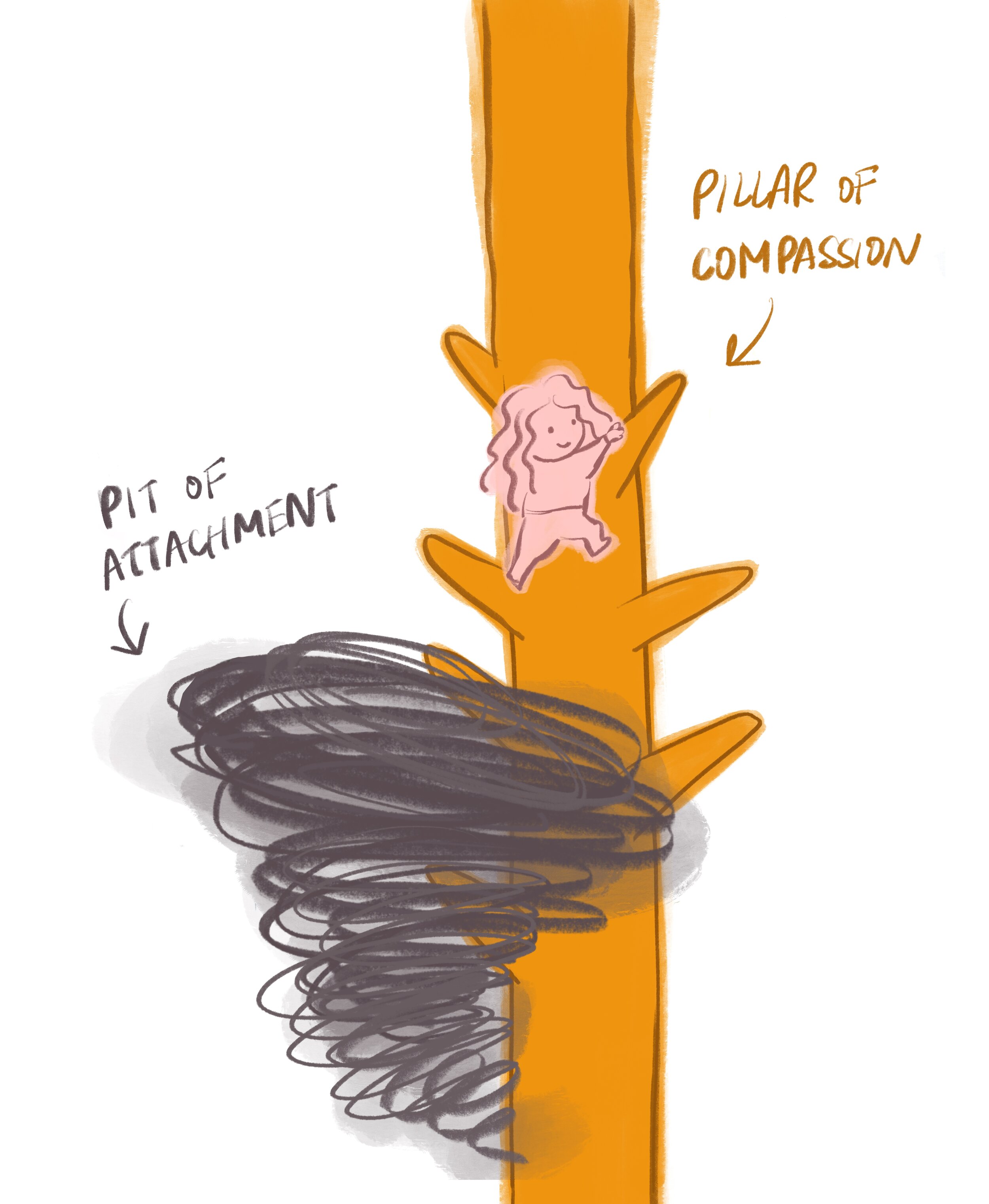The Cycle of Emotions - A guide to influencing reality
Four years ago, the layer of my reality was unexpectedly peeled back, revealing my first glimpse into the operating system behind it.
I was running my innovation consultancy at the time, learning my way through client work, managing a team, and selling projects. It was an incredibly exciting period of my life, but also a stressful rollercoaster of emotions. In the tough times, I would often find myself in a pit of frustration and anxiety: Why is my client being so difficult? Why am I not better at this? Why am I not smarter, more charismatic, more capable? What if I’m not good enough to create the positive change in the world that I hope for?
While in this pit, I would hear a soft voice inside me whisper, “There is a better way of existing...” I didn’t know what that meant but I felt the need to find out. Through many months of seeking, I found myself at a mysterious gathering in a forest in Minnesota. One of the extraordinary people I met there was Hans Krueger - a seasoned innovation leader who has studied the wisdom of Nyingma Buddhism for many years. He introduced me to the Cycle of Emotions - a practical framework for understanding the interrelationships of our emotions. It opened my eyes to the operating system behind my reality and ways to influence it, helping me realize that I can be the conscious designer of my life. I have used this tool every day for the past four years to climb out of pits of negativity and cultivate a healthy state of mind.
Mastering the Cycle of Emotions will take a lifetime, perhaps several. Acknowledging that I still have much to learn, I am sharing what I understand so far in hopes that more people can benefit from it.
Note: My adaptation of the Cycle of Emotions includes new elements to make this more relatable to a modern audience. If you would like to read the source text, you can find it in the book “Kindly Bent to Ease Us- Part One: Mind” by Nyingma Buddhist teacher Longchenpa.
The Operating System OF Our Reality
To influence our reality, we must first understand the operating system within us that determines how we perceive reality.
It is composed of four Pillars* - Love, Compassion, Joy, and Equanimity. These Pillars support the Platform of Radiance, on which our mind can rest.
When our Pillars are strong, our Platform of Radiance is balanced and stable. Our perception of reality is clear and unfiltered by negative emotions. To keep our Pillars strong, we must cultivate them through daily practices:
To cultivate a strong Pillar of Love, we must develop practices that enable us to connect deeply with our authentic self and that of others, providing a sense of meaning.
To cultivate a strong Pillar of Compassion, we must develop practices that enable us to value others’ wellbeing as equal to our own, providing a sense of expansion.
To cultivate a strong Pillar of Joy, we must develop practices that enable us to express our authentic self by tapping into our inner energy source, providing a sense of flow.
To cultivate a strong Pillar of Equanimity, we must develop practices that enable us to see with calm, clarity, and acceptance, providing a sense of relaxation.
When we do not cultivate our Pillars, they grow weak and our Platform of Radiance becomes unstable, causing us to fall into one of the four Pits of Suffering below.
Each Pillar has a corresponding Pit of Suffering:
Love > Attachment
Compassion > Sentimentality
Joy > Elation
Equanimity > Apathy
When in a Pit of Suffering, what we experience is a distorted view of reality. It’s like seeing the world through thick filters that exaggerate, block out, or warp what’s really there. Some emotions seduce us by feeding our egos. Others weaken us by hooking onto our insecurities. If we are not careful, we can be pulled deeper and deeper into these Pits. Some of us never climb back out, forever living in a distorted reality.
Fortunately, each Pit of Suffering has an antidote, which happens to be the cultivation of the Pillar to the right of it. The relationship between Pits and Pillars forms the Cycle of Emotions.
The Pit of Attachment
How we end up here:
While we cultivate the Pillar of Love, our feelings of connection may devolve into feelings of attachment - a desire to own or have things go the way we want them to go. When we realize that we cannot control what we have become attached to, we tumble into this pit.
Emotions we may find here:
Craving, frustration, anger, rage
Antidote: cultivate the Pillar of Compassion
Practice acknowledging that everyone, including ourselves, is doing the best that we can. Shift our focus away from our desire to control towards caring about the wellbeing of ourselves and others.
How can I learn to accept the extent of my capabilities and care about my own needs?
How can I learn to accept the extent of others’ capabilities and care about their needs?
Resource: My “Compassion” personal reflections and best practices
The Pit of Sentimentality
How we end up here:
While we cultivate the Pillar of Compassion, our focus on reducing suffering may devolve into sentimentality - a feeling of helplessness, “if things were just different, all would be well”. When we are so overwhelmed that we believe that there is nothing we can do, we tumble into this pit.
Emotions we may find here:
Pity, envy, jealousy
Antidote: cultivate the Pillar of Joy
Accept that we have done everything we can about this suffering. Reignite our energy to lift us out of feelings of sentimentality by doing activities that make us feel aligned and in flow with our authentic self.
What can I can do to express my authentic self more fully?
What are things that I appreciate about myself and others?
What are things that I am feeling grateful for?
The Pit of Elation
How we end up here:
While we cultivate the Pillar of Joy, our energy may lift us so high off the ground that we devolve into elation. When our sense of self becomes inflated and we become attached to ungrounded goals, we tumble into this pit.
Emotions we may find here:
Ecstasy, arrogance, hubris
Antidote: cultivate the Pillar of Equanimity
Bring ourselves back down from the clouds by grounding ourselves in the present moment and in our bodies. Once we are in a state of relaxation, no longer bombarded by thoughts, we can attain a clearer and more expansive view of what is real.
Are there other perspectives and ideas that I am not considering?
Am I open to the possibility that I might be wrong and have more to learn?
Resource: My “Equanimity” personal reflections and best practices
The Pit of Apathy
How we end up here:
While we cultivate our Pillar of Equanimity, our calm may devolve into apathy. When we become disconnected from ourselves and others, we tumble into this pit.
Emotions we may find here:
Passivity, ignorance (when you no longer care enough to understand), fear (we fear what we have not explored), aversion, hatred, sadness, depression
Antidote: cultivate the Pillar of Love
Shift from disconnection to connection by cultivating loving-kindness. Learn to see and care for our authentic self and that of others. Fear and love cannot exist at the same time.
What can I do to understand, connect with, and value my authentic self?
What can I do to understand, connect with, and value others, especially those who are very different from me?
Summary of the Cycle of Emotions:
How to apply the Cycle of Emotions to influence reality:
Take three slow deep breaths to connect with your self and the present.
Reflect on where your mind is in this moment - sitting atop the Platform of Radiance? Swirling in a Pit of Suffering?
If you have found yourself in a Pit of Suffering, what emotions are you feeling? Which Pit might you have fallen into?
Reflect on how you may have ended up here:
Pit of Attachment: What might I be attached to?
Pit of Sentimentality: What might I be feeling helpless about?
Pit of Elation: What goals or perspectives might I be caught up in?
Pit of Apathy: What might I be disconnected from?
Reflect on which antidote Pillar you need to cultivate to climb back onto the Platform of Radiance. What first steps can you take towards cultivating this Pillar? (You may want to experiment with a few methods to find what works best for you. For inspiration, you can see my collection of personal practices in “My Radiant Life Toolkit”.)
Pit of Attachment > Cultivate the Pillar of Compassion
Pit of Sentimentality > Cultivate the Pillar of Joy
Pit of Elation > Cultivate the Pillar of Equanimity
Pit of Apathy > Cultivate the Pillar of Love
Notice how you feel after you have spent some time cultivating your Pillar. If there are still emotions remaining, you may be in other Pits and need to cultivate other Pillars. Repeat the exercise as many times as you would like.
By adding the Cycle of Emotions to our mental toolbox, we can gradually build our awareness and mastery over our internal operating system. As the strength of our Pillars grow, we will be in more control of our response to what life throws at us. We will still find ourselves falling into Pits of Suffering; however, with the Cycle of Emotions as guidance, we have the ability to consciously pull ourselves out and live more of our life on the Platform of Radiance, in a reality of fulfilment.
Related writing and Resources:
My Radiant Life Toolkit - A collection of personal practices and resources for cultivating the four pillars
Thank you to Hans Krueger for sharing this wisdom with me so many years ago and for continuing to teach me in our recent conversations. Thank you also to all my friends who have given feedback on the many versions of this over the past few months: Amanda, Amelia, Meghan, Crystal, Bill, Eddie, Fernando.
*In Buddhism, the four Pillars are called the “Four Immeasurables”.
Want to be notified of new posts?
Subscribe to my newsletter





















Alien masks, golden sceptres, and many questions to be answered